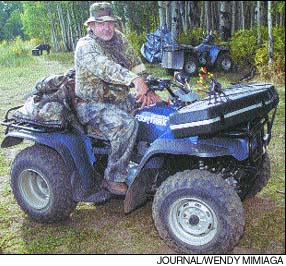|
Sept. 23, 2000 By Janelle Holden After two years of negotiations, public comment, and hard work, recreation guidelines developed by Colorado’s three BLM Regional Advisory Councils suffered a legal setback this month. Legal advisers to the BLM told land managers that before any regulations of off-highway-vehicle travel could be implemented, an inventory of roads and trails on state BLM lands would have to be completed. The BLM had planned to prepare a statewide Environ-mental Impact Statement/Plan Amendment to amend the current designations for cross-country travel in its land-use plan. This amendment would have been based on the nine pages of recreational guidelines drawn up by three state RACs over the past two years.
The guidelines were intended to limit off-highway vehicles such as ATVs, snowmobiles, and mountain bikes to existing roads and trails so that the BLM could conduct an accurate transportation inventory of BLM land in Colorado. However, BLM officials said they recently were advised that legally they could not submit a land-use-plan amendment without a complete inventory of roads to use as a baseline. "We didn’t expect that, to be honest," said Roger Alexander, public-affairs specialist for the BLM in Montrose. Colorado’s RACs took the initiative in 1998 to create recreation guidelines that would comply with newly created land-health standards. The RAC members felt that it was not only important for the BLM to apply these standards to grazing practices, but also to recreation. "It raised the awareness of both the agency and the public that recreation is not this benevolent kind of use of public land, that it does in fact have impacts, and in some cases those can be very substantial impacts on natural and cultural resources," said Alexander. The recreation guidelines have been available for public comment since Aug. 8. The last day for comment was Friday, and Dennis Zachman, a project-management specialist in Lakewood, said the agency had received 60 comments on the guidelines as of Tuesday. He said a primary goal was to complete a transportation inventory across the state, but in the interim the RAC had wanted to provide the agency with a set of guidelines for off-highway vehicles. "Most of the components of our draft have a lot of merit, and we’re going to continue to use them," said Zachman. Zachman and Alexander said that the BLM would compile a priority of areas to inventory and invite public comment on each of them. Zachman said that will take some time to complete. About half of BLM land is currently open for OHV use. The recommendations do not include suggested closures, just restrictions to current roads and trails. BLM land is categorized by open, limited, or closed categories for cross-country travel. Zachman said that most of the land-use plans were completed before 1990. "At that point, in many areas, the OHV was just not a big issue," said Zachman. Until now, the BLM has allowed off-road travel anywhere that it wasn’t specifically prohibited. The recommended recreation guidelines state, "When developing travel management plans and/or implementing travel management decisions.... Allow off-road motorized travel only in areas that clearly meet the designation criteria for ‘Open’ areas and that meet the Standards for Public Land Health." They also asked the BLM to set aside areas, limited in number and size, for certain high-impact recreational uses, such as off-road vehicles, motorcycles, and target practices. The guidelines try to strike a balance between preserving land and allowing some recreational off-highway-vehicle use. The BLM also conducted public meetings for a national strategy on OHV use this summer. "We need the public’s help to find ways on how to keep pace with the growing use of OHVs while conserving our natural resources," said BLM Director Tom Fry in a press release. The BLM’s management of OHVs is guided by an executive order issued in 1972, when only about 5 million OHVs were in use nationally. Since then, the number of OHVs has risen dramatically, and technological advances now make it possible for these vehicles to travel over lands that were formerly inaccessible. BLM officials have said that many of BLM’s land-use plans do not adequately address OHV use, and the agency’s budget-related resources — including the number of recreation specialists and law-enforcement personnel -— have not kept pace with the past decade’s growth in OHV use. The comments collected from the public meetings are being analyzed and implemented into a guidance policy by Nov. 30. |
||||
|
Copyright © 2000 the Cortez
Journal. All rights reserved. |
